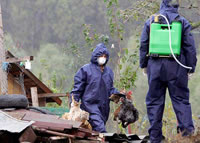The sudden death of Dr. Lee Jong-wook, director-general of the Word Health Organisation (WHO) threw the UN agency in turmoil on the opening day of the annual assembly in May in Geneva. It was Dr. Lee who brought the fight against diseases as bird flu (H5N1) to a higher level.
The threat of a global bird flu pandemic has ignited an unprecedented public health preparatory response. Key to all containment and response strategies is an all included surveillance system. Experts agree that when there are surveillance gaps, protections can lapse. As late Dr. Lee said: ‘The SARS epidemic showed us that we cannot afford any gap in our global surveillance and response network’.
But there still exist gaps in these networks, Taiwan for instance. This country with 23 million citizens is not included in WHO surveillance systems. Trade and migration patterns place this island at the crossroads or within close proximity to the epicenter if any infectious disease outbreak in the south-east Asian region. There are innumerable ways for diseases to enter or leave Taiwan.
Taiwan’s strategic geographical positioning can fill critical surveillance related to major pandemic threats. Inclusion of Taiwan in the Global Outbreak and Alert Response Network (GOARN) of the WHO should enhance global health security. Many global professional organisations endorse this inclusion, among them the International Congress of Nurses, World Health Professions Alliance and International Pharmaceutical Federation, but also United States Congress and European Parliament.
In the meantime the World Health Organisation intensified its investigation into clusters of humans infected with the bird flu virus (H5N1). A WHO team is studying seven confirmed cases of which six have died.
The Indonesian case raises the possibility of transmission of the virus for the first time from a sick bird through one human to two others. This kind of transmission from an infected person to another has been identified as likely in two other countries, in Thailand and Vietnam.
But samples of other cases couldn’t be analysed; researchers were hindered by local traditions requiring rapid burial, so making autopsies not possible.
‘Although human-to-human transmission of H5N1 can’t be ruled out, the search for a possible alternative source of exposure is continuing’, a WHO spokesman stressed. In the meantime traders attributed weakness in the Indonesian rupia and the Australian dollar to fears that the cases could mean a warning of a human flu pandemic.






